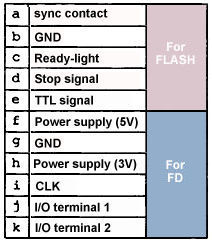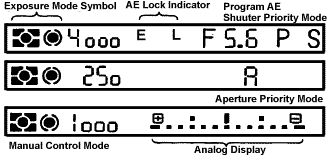Nikon Adjustment Screwdriver for DP20Description:
■Appearance of the item This item is NEW / OLD STOCK Condition. All photos are of actual items up for bids, No Retouching. Please check on the photos for detailed condition of the product.
No problem.
■Including Nikon Screwdriver. (No Box) If you have any question or concern, please do not hesitate to contact me. Thank you for visiting. |
|
Shipping:
The shipping method is: PTT (Turkish Postal Service ) - Economy International Shipping
All these services are offered by ;

We will ship the item 3 business days after your payment clears.
All items are sent using Turkish Post International Registered Mail Service for which a tracking number is provided upon despatch. This tracking number does not provide real-time tracking updates, however, it will show the current delivery status for the parcel.
The tracking number can be used on the Turkish Post Office website here:
This will give the date at which the parcel left Turkey and the date at which it was delivered in recipient country.
Once the item is shipped, I will email you with the tracking number.
All items are sent using International Registered Mail Service. ( Airmail )
Please see below for approximate shipping times according to location.
SHIPPING TIME: (for: Economy Shipping)
| North and Central America | South America | Europe | Asia | Oceania |
|---|
| 2 to 4 weeks | 2 to 4 weeks | 2 to 3 weeks | 2 to 3 weeks | 2 to 4 weeks |
SHIPPING TIME: (for: Expedited Shipping)
| North and Central America | South America | Europe | Asia | Oceania |
|---|
| 3 to 5 days | 3 to 5 days | 3 to 4 days | 2 to 4 days | 3 to 5 days |
Terms of Sale: - All returns accepted
- Your buyer should contack you within 14 Days after receiving the item.
- Refund given as Money Back.
- Return shipping will be paid by your buyer.
- No restocking fee will be charged.
About Us: We are at cameras & lenses and All Kinds of TURKISH Origin Products Since 2007, business in Turkey. If you have any question, please feel free to contact us. And, if you are looking for any particular item, I'd be happy to help you find it. Thank you very much ! International Buyers - Please Note: ・Import duties, taxes and charges are not included in the item price or shipping charges. These charges are the buyer’s responsibility. ・Please check with your country’s customs office to determine what these additional costs will be prior to bidding/buying. ・These charges are normally collected by the delivering freight (shipping) company or when you pick the item up - do not confuse them for additional shipping charges. ・We do not mark merchandise values below value or mark items as “gifts” - US and International government regulations prohibit such behavior.
Copyright c 2012 xxxxxxx. All rights reserved. |
|
|
 | Multi-Meters Finder DP-20
The Multi-Meter Finder DP-20 is the Nikon F4(s) standard finder and highly recommend as it optimizes performance of the F4. It offers a high eyepoint of 22mm and virtually 100% picture frame coverage. Unlike any of the other eye level finder(s) designed for the previous F-models, the DP-20 multi-metered prism is a high-tech viewfinder that delivers many enhancements. In addition to the metering system selector, the following functional parts have been incorporated:
|
The metering system in F4 is comprised of TTL Matrix, Center-weighted and Spot metering. You can calibrate full aperture exposure compensation as well as electrical exposure compensation. The metering range (with 50mm f/1.4, ISO 100) starts from EV0-EV21 (up to EV16+ 1/3 stop) with TTL Matrix metering; EV-2 ~ EV21 (with AE Action Finder DA-20) in Center-Weighted Metering; while spot metering is effectvelly operative at EV-2 ~ EV21 in TTL Spot Metering.The Metering algorithm is similar to that of the previous F801(s).  |
The DP-20 will revert itself as an Electronic Rangefinderin situation when the Nikon F4 is operated in Manual Focus mode. This feature will work with AF-Nikkor, Ai-type Nikkor (which includes Ai-modified Nikkor and even Non-Ai Nikkor) with a maximum aperture of f/5.6 or faster. Although most of us know how to handle manual focus on our own, the electronic rangefinder is just a focusing guide to tell you which way to focus (direction(s) in turning your focusing ring) and when the subject is sharply focus, the green in-focus symbols lights up - that is all, nothing fancy with the sexy term that it carries. However, but an advantage the F4's electronic rangefinder presents is - it works down to as low as EV-1 (single candle light source), a feat which is useful when some of you who may be struggling to focus with slow speed tele-lenses and/or specifically for people who starts to develop deteriorating eyesight syndrome (such as me). ..hehe..
|
In addition to the metering system selector, the following functional parts are incorporated: 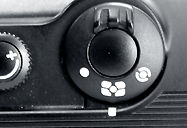 | Metering Pattern Selector Dial he three available metering system: Matrix, Center-Weighted and Spot metering can be easily switch back and forth via a handy selection dial located just at the top right hand side of the prism. The three symbols  , ,  and and  represent: the spot, CW and multi-segments metering available for handling accurate ambient light measurement. represent: the spot, CW and multi-segments metering available for handling accurate ambient light measurement. |
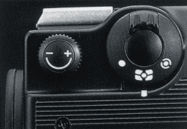 | Diopter Adjustment Knob Diopter is built-in on the Nikon F4. Located just next to the metering pattern selector dial, the knob enables near-or far-sighted photographers to adjust eyepiece diopter within a continuous range of from -3 to +1. Pull the knob and rotate it to either direction until focused image appears sharp, then push back. For diopters beyond this range, Nikon eyepiece correction lenses for F3HP can be used with the F4. |
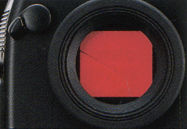 | Eyepiece Shutter Lever This was first used on the Nikon FA back in 1983. During self-timer operation, as the metering cells are located inside it is always recommended to use the eyepiece shutter which will prevent light from entering from the rear section which may adversely affecting the automotic exposure meter reading during self timer operation and/or shooting macro or unmanned with tripod. Simply just turn the lever to the left to close the shutter. The eye piece shutter is painted red to provide a visual reminder that it is in use. |
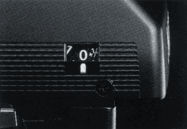 | Exposure Compensation Dial for Interchangeable Focusing Screens This feature is located in the finder, it may be neccessary to compensate the measured value when using certain interchangeable focusing screens. Compensation is possible within the range of -2 to +0.5 EV steps. |
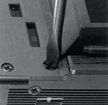 | To adjust, remove the finder from the camera body and rotate the screw-like dial with the screwdriver provided, while referring to the compensation value scale window and the instruction manual for the screen concerned. |
Specification of Nikon Multi-Meter Finder DB-20
Viewfinder: Removable type Pentagonal roof-prism Eye-Level viewfinder
Field of viewfinder: 100+0, -2%
Viewfinder diopter: -3 to +1 DP (adjustable by dial operation)
Magnification and Eyepoint (from the rear of eyepiece lense)
Diopter (DP) | -3 | -2 | -1 | 0 | +1 | Magnification | 0.72 | 0.71 | 0.70 | 0.69 | 0.67 | Eye Point (mm) | 17.6 | 19.6 | 22 | 24.7 | 27.6 |
Inside viewfinder (when mounted on the body)
Top section of the focusing screen: (1) LCD indicators on the body (exposure compensation value, frame counter with data back); (2) Aperture value (direct reading); (3) LED indicators on the body (AF focusing information, exposure compensation mark, flash ready-light)
Bottom section of the focusing screen: Built-in LCD indicator in viewfinder, viewfinder illuminator (green) (Exposure information, metering mode, exposure mode, analog display (in M mode), and AE lock indicator). * Viewfinder illuminator lights up in shutter pre-release operation.
Eyepiece Shutter (built-in): Red colour, two-blades construction
Eyepiece Unit: Eyepiece lens system (3 elements in 3 groups optical design, central lense is movable) Power Consumption: Approx. 20mA for the viewfinder only. Approx. 26mA when illuminator lights up. Max. available voltage: 4.8V to 6V
Exposure Metering Range: EV1 to EV21 (at ISO 100 f/1.4)
Exposure metering mode Selector:
(1) Spot metering mode: Metering with spot metering FPC mounted in the bottom body (equivalent to spot metering circle ( 5)) 5))
(2) Multiple metering mode: Multiple exposure metering by five-separate area
(3) Center-weighted mode: Exposure metering by central part of five-separate area SPD (equivalent to counterweighted metering circle ( 12)) 12))
Focusing Screen Compensation: -2, -1-1/2, -1.0, -1/2, 0, +1/2 (compensation value is displayed in the window of the inside viewfinder) | Screen compensation s NOT necessary | Type J, K, P, B, E | | Screen compensation is necessary | Type C, M, G1, G2, G3, G4, F, U |
* Note: a. Multiple exposure metering is available only on the focusing screen which does not - as a rule, needs any exposure compensation; b. Select compensation value by the combination of the focusing screen lenses.
Dimensions: 117.3mm (height) (camera body); 55mm (viewfinder width), 76.6mm (depth of viewfinder)
Weight: 170g Accessory Shoe Other than the metering function, actually is one of the most significant improvement made to the F4's finder system. It was actually the decision to revert back to universal ISO-type accessory shoe design. The Nikon F4 was the first pro F-series model that adopted the mainstream flash shoe design instead of following a proprietary accessory shoe design used in all previous F-series models of Nikon F, F2 and Nikon F3. This has enabled the Nikon F4 to be compatible with other Nikon AF cameras and it is even be able to tab on numerous Nikon speedlights designed over recent years. |











